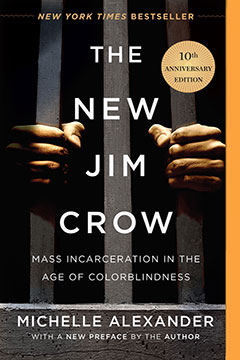Everything and Nothing Has Changed. Ten Years after The New Jim Crow Was first published.

In January 2020 we published the tenth anniversary edition of Michelle Alexander’s The New Jim Crow: Mass Incarceration in the Age of Colorblindness. This landmark book argues that the racial caste system in America never ended—it was simply redesigned—and that today’s criminal justice system functions as a contemporary system of racial control.
Alexander’s cogent and incisive critique did what few books do, starting a national conversation around race and criminal justice reform. Since it was first published The New Jim Crow has spent nearly 250 weeks on The New York Times Best Sellers list, it has been cited in judicial decisions, it helped inspire the creation of institutions like the Marshall Project, and it empowered a whole new generation of activists.
In a recent story, The Daily Kos looked back at legacy of The New Jim Crow and its impact on the zeitgeist, saying:
Ten years later, the book continues to offer a useful and revealing way to understand the current state of affairs in criminal justice. This week, The New Press released a Tenth Anniversary Edition of the book, featuring a new preface where Alexander assesses the book’s impact and discusses the current state of the criminal justice reform movement.
Since 2010, she has consistently returned to the themes of her seminal work. In a 2018 op-ed for the New York Times, “The Newest Jim Crow” Alexander delved into the underside of reforms that merely tinker around the edges of the criminal justice system. While acknowledging notable gains, including restoration of the right to vote for people with felony convictions in Florida, bail reform, changes to drug policy, and “ban the box,” Alexander nevertheless warned that the “current reform efforts contain the seeds of the next generation of racial and social control, a system of ‘e-carceration’ that may prove more dangerous and more difficult to challenge than the one we hope to leave behind.”
An excerpt from the new preface to the tenth anniversary edition was recently published in The New York Times. In it Alexander writes: “It has been an astonishing decade. Everything and nothing has changed.” She takes stock of what has changed: we have a new president in the White House who has embraced a rhetoric of racism, bigotry, and white nationalism, but there has been a groundswell of activism and modest reforms have been made. And lists all that remains the same with our criminal justice system and the culture at large: the villanization and imprisonment of immigrants; continued police violence; and the disproportional the impact of drug enforcement, policy, and negative sentiment on communities of color.
In a recent interview with The New Yorker’s David Remnick, Michelle Alexander was asked about the idea of everything and nothing changing. She answered:
As I wrote, a system of mass incarceration had been born in America, a system of racial and social control that turned back much of the racial progress we thought we had made, and people were unwilling to talk about it and to face it. Criminal-justice issues weren’t even really on the radar of civil-rights organizations at that time, with the exception of the A.C.L.U. and some work on racial profiling that was beginning to be done by the N.A.A.C.P. and other organizations. When the Leadership Conference on Civil Rights, in 2008, sent out a letter listing the most pressing issues on civil rights, criminal-justice issues didn’t even make the list. And when, in 2009, the Congressional Black Caucus sent out a list of a couple dozen issues that might be of concern to black communities, criminal justice didn’t make the list. This was just as the drug war was raging and the race to incarcerate was going full bore. And so there was a way in which we were asleep and in denial.
Today, that has changed. The election of President Trump has completely decimated whatever fantasies we had that we are living in a post-racial America. We now can see that systems of racial and social control are alive and well, not only due to the uprisings in Ferguson and the many, many publicized police killings of unarmed black people and the growing movements to end mass incarceration. We’ve also come to see how yet another system of racial and social control has been born in this country, the system of mass deportation and mass detention. So we have this paradox in which, on the one hand, it seems that everything has changed, yet the politics of white supremacy have remained largely unchanged during the Obama years. Now we are forced to reckon with racial realities that we had long attempted to avoid, and I think we are finally beginning to see how the politics of divide and conquer, the politics of racial scapegoating and fearmongering, have been used again and again.
Everything and nothing has changed. In that space, The New Jim Crow remains as important now as ever. This week, a month after the publication of the tenth anniversary edition, The New Jim Crow returns to The New York Times Best Sellers list. As Slate recently wrote, The New Jim Crow “transformed forever the way thinkers and activists view the phenomenon of mass incarceration.” And it will continue to for years to come.
